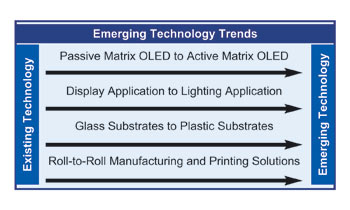Supply-and-demand issues must be addressed before OLEDs are widely used in large displays.
Rengarajan Srinivasan, Frost & Sullivan
Organic light-emitting diodes (OLEDs) are quickly becoming the next generation of small displays. Although the technology is still emerging, it has been used already in personal media displays such as MP3 players and mobile phone subdisplays. The advantages offered by OLEDs — slimmer and thinner displays and the lack of backlight — are driving their adoption.
Further commercialization of OLEDs is dependent upon the success of current research. The major challenges faced by the industry are in large-scale manufacturing, and in material lifetime and efficiency. The use of vacuum deposition techniques for small-molecule OLEDs is not feasible in the large-scale manufacturing of bigger displays. At present, 2-in. panels are the most common size in use; however, market participants are focusing on displays of larger than 15 in.
Two types
With respect to the materials used, OLEDs can be broadly classified as small-molecule or polymer-based types. Small-molecule OLEDs appeared first and are available in two versions: fluorescent and phosphorescent. Fluorescent small-molecule is widely used and offers reliable manufacturability and good lifetime. Phosphorescent small-molecule OLEDs have emerged recently and offer greater luminous efficiency than their fluorescent counterparts. The major drawback in using small-molecule OLEDs is their complex manufacturing process. Moreover, they require additional materials such as phosphorus to enhance efficiency.

Development in the OLED market shows progression in technology, applications, materials and manufacturing processes. Courtesy of Frost & Sullivan.
Recent research has concentrated on polymer-based OLEDs, which are less expensive, more efficient and suitable for large displays. They are solution-based and can be manufactured by solution deposition techniques such as ink-jet printing to simplify manufacturing. Currently 99 percent of the OLEDs on the market are small-molecule types, but the success of polymer-based OLEDs is expected to create more market opportunities, especially if their efficiency and lifetime can be increased.
The current applications for OLEDs are in direct competition with well- established flat panel technologies such as LCD and plasma. The increasing acceptance and decreasing price of LCDs pose a serious challenge to the adoption of OLEDs. The large-display manufacturers who have invested in LCDs have yet to break even, discouraging them from investing in the development of OLEDs. To compete with other technologies, OLED manufacturers are forced to reduce their prices and risk low profit margins.
However, some technological advances are encouraging leading display manufacturers such as Samsung SDI of Seoul, South Korea, to pursue OLEDs for large panel displays. The development of active matrix OLEDs and the increase in the lifetime of organic materials are essential for manufacturing large-screen displays. The use of thin-film transistor-based active matrix technology is an ongoing research issue, which is focused mainly on silicon, low-temperature polysilicon and organic thin-film transistors. The emergence of active matrix OLED displays is necessary to compete with LCDs in the display market.
The delay in time to market also is slowing adoption of the technology. The involvement of a wide variety of value chain participants is creating complexity in product development. The value chain is represented by organic material developers, technology developers and manufacturing equipment producers.
And consumer demand fluctuates, as does the supply of organic materials necessary for manufacturing OLEDs; both variables create unease in the industry. Companies are developing strategies to boost production and to decrease time to market. Moreover, the OLED industry requires high initial investments, and a mismatch between investments and production dynamics will lead to reduced profit margins. Cooperation among manufacturers, suppliers and end users will help in forecasting consumer demand more accurately, which will save money.
Finding the application
The growth of OLED technology is dependent also upon finding a niche application. The use of novel substrates such as plastic and glass is enabling new applications, just as the use of OLEDs in flexible and transparent displays will create opportunities for many vertical markets. For example, flexible displays can be used in e-papers, and transparent displays in car windshield information displays. The energy-saving nature of OLEDs has made them attractive in lighting applications. Initiatives from major lighting firms, such as General Electric of Cleveland, Philips of Amsterdam, the Netherlands, and Osram of Santa Clara, Calif., are aimed at bringing OLED lights to consumers. The initial lights are expected to be in use in signage and decorative applications by 2010.
OLEDs have many technical advantages, but the success and commercialization of this technology will depend on the results of ongoing research. The participants in this market must concentrate on specific end-user applications and determine a strategy for how to make supply, including both materials and processes, meet demand
Meet the author
Rengarajan Srinivasan is a research analyst with Frost & Sullivan in London.